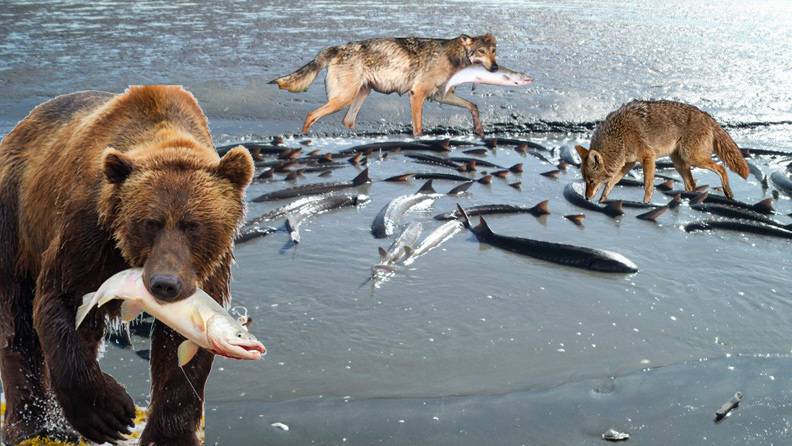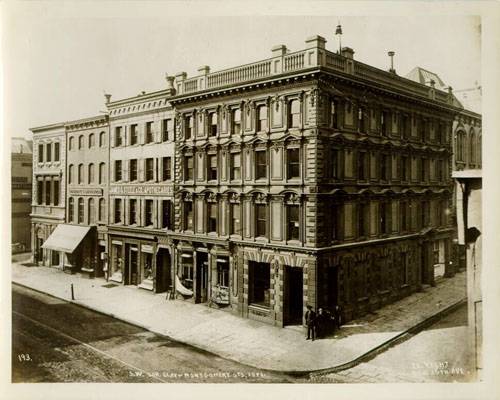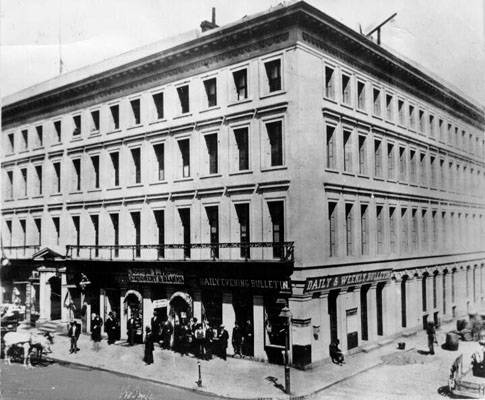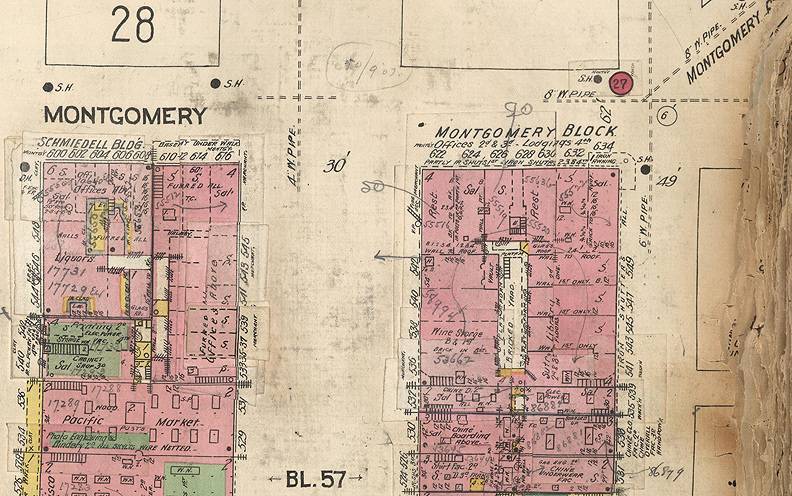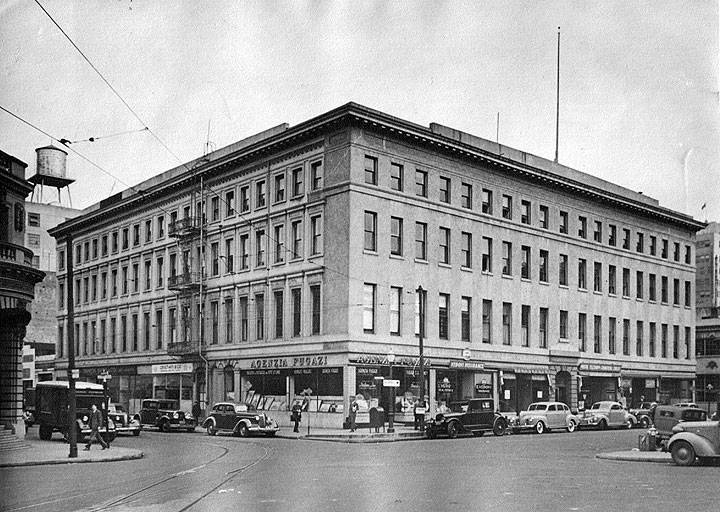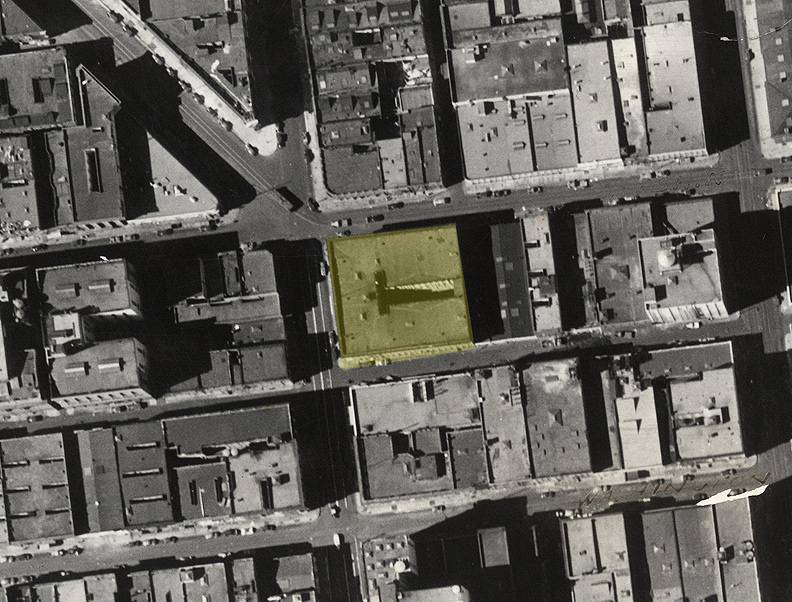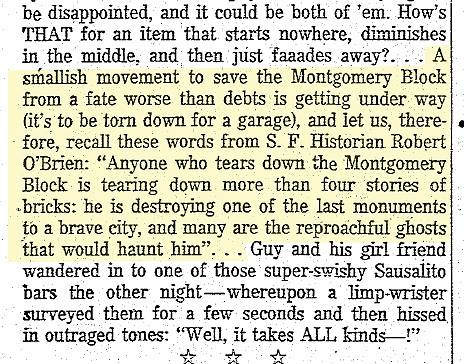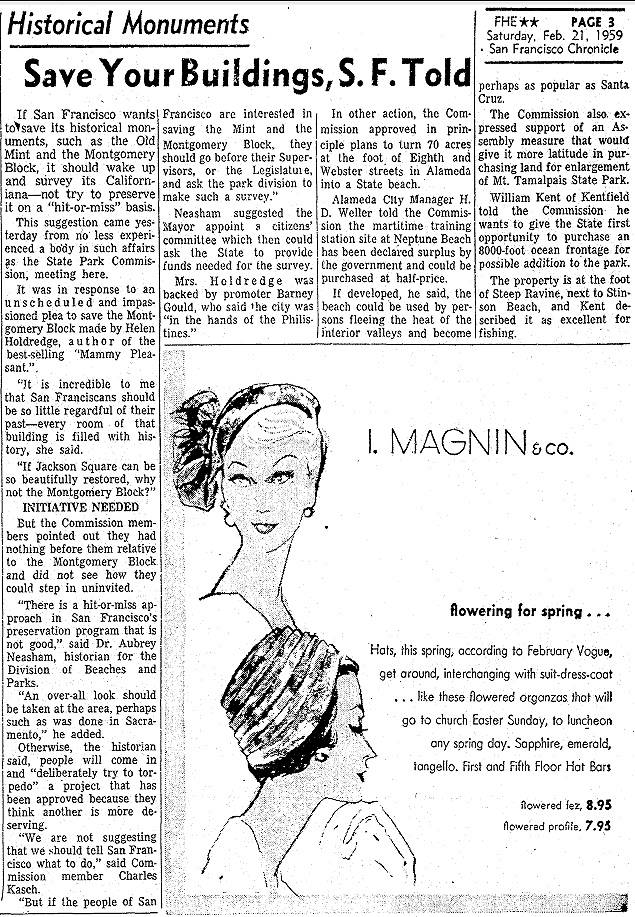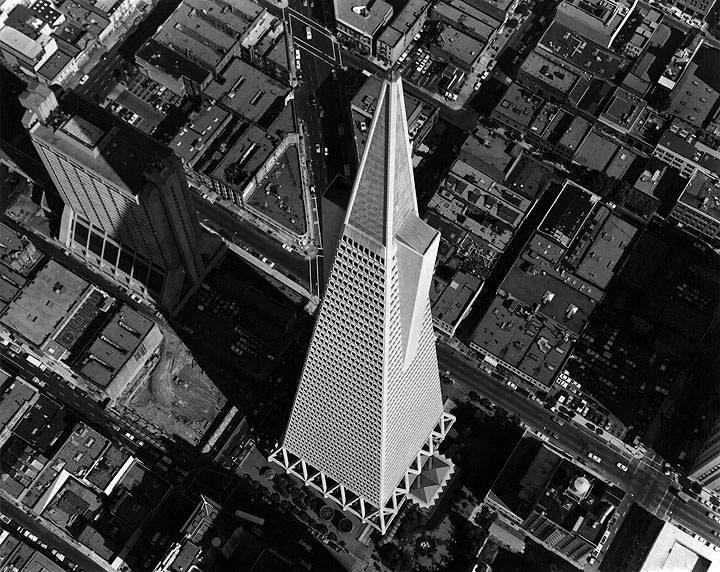From Fish-Choked Mudflat to the Pyramid
Historical Essay
by Chris Carlsson
Grizzly Bear, wolf, coyote, competing for tide-beached sturgeon.
Collage by Chris Carlsson
“[In 1837 or so, in] the cove of Yerba Buena, or San Francisco, as it soon came to be called, was the great number of good-sized fish that swam close in shore and were stranded by the outgoing tide … I often used to sit on the veranda of my father’s house [at apx. today’s Clay and Grant] and watch bears, wolves, and coyotes quarreling over their prey along what is now Montgomery Street.”
—Steven Richardson, “Days of the Dons”
That old shoreline at Montgomery filled in rapidly as the Gold Rush brought thousands to California, most of whom landed first in San Francisco in 1849 or 1850. After several major fires leveled the instant city over a couple of years, a very substantial brick structure was erected on the intersection of Montgomery and Washington in 1853, known as the Montgomery Block, burying forever the original beach and shoreline. When it was built it was the largest commercial structure in the United States west of the Mississippi River.
1857 U.S. Coastal Survey Map, showing the Montgomery Block long before the diagonal boulevard (today's Columbus Avenue, originally Montgomery Avenue) was established.
Southwest corner of Clay and Montgomery, c. 1870.
Photo: San Francisco History Center, SF Public Library
The Montgomery Block building in 1880.
Photo: San Francisco History Center, San Francisco Public Library
1905 Sanborn insurance map showing in detail the block bounded by Washington and Clay with Montgomery on its west side. Note Merchant Street (alley) bisecting the block.
Historian Harvey Smith describes the arts community that developed over the decades in and around the Montgomery Block building:
… the huge brick Montgomery Block building served initially as studios and apartments for writers including [[MARK TWAIN|Mark Twain], Bret Harte, Ambrose Bierce, Robert Louis Stevenson, Jack London, George Sterling, and Emma Goldman. The building miraculously survived the San Francisco earthquake and fire of 1906. By the 1930s, as many as 75 artists and writers had studios or apartments with rents as low as $5 per week in the building they had affectionately dubbed the “Monkey Block.” They and other artists were part of a lively arts scene that carried over into the bars and restaurants of the surrounding neighborhood. Luminaries such as Diego Rivera, Frida Kahlo, Ralph Stackpole, Maynard Dixon, Dorothea Lange, Benny Bufano and Sargent Johnson were part of this vibrant community which by the early 1930s epitomized the working relationships fostered by the federal government’s programs for the arts.
Montgomery Block, 1930s
Photo: Courtesy of Jimmie Shein
The Montgomery Block in 1933.
Photo: San Francisco History Center, San Francisco Public Library
Aerial shot in 1938 of Montgomery Block.
Photo: courtesy David Rumsey collection
After more than a century of use, the venerable Montgomery Block was torn down in 1959, before any meaningful architectural preservationist effort had begun. City Lights founder Lawrence Ferlinghetti and some other bohemians and beats picketed the planned demolition site prior to its destruction, but to no avail. Herb Caen quoted historian Robert O’Brien decrying the impending demolition, while other preservationists rallied to the cause, but as it turned out, to no avail.
Herb Caen's S.F. Chronicle column, Jan. 5, 1959.
San Francisco Chronicle, Feb. 21, 1959.
After a decade of serving as a parking lot the Transamerica Corporation proposed to build its iconic pyramid on the site. In order to make it financially lucrative enough, they sought city approval to close various streets and make them part of the parcel on which the pyramid would be built. Following a decade-long process of selling off city streets and rights of way for a fraction of their commercial value in order to facilitate major building projects (e.g. the Embarcadero Center and the Golden Gateway apartments all took over a number of smaller streets to grow the size of their parcels and enlarge the rentable floorspace of their projects), Citizens had begun to organize systematic opposition to selling public rights of way. Many objected to the eyesore they saw in the design for the Transamerica Pyramid, and hundreds appeared at an August 25, 1969 Board of Supervisors meeting to oppose approval for the building. According to historian Alison Isenberg this was both the peak of public mobilization and also a decisive loss for its opponents.
Measured by the protestors’ demands, the August vote of 9 to 1 in favor of vacating 183.3 feet of Merchant Street was a complete defeat. The tallest building in San Francisco (up until 2017), in the shape of a pyramid, had been approved for the contested location, and another street had been sold at half price to a developer without discernible public benefit.(1)
But the story didn’t end there. Two attorneys, one of whom had just finished law school in 1969, led a public-interest effort to redefine the process and the value of the street closures going forward. John Harman and Hal Howard filed “three Transamerica-inspired taxpayers’ cases that would change the city’s rules governing the closure and sale of public streets to developers: Albert Meakin v. City and County of San Francisco et al. (Meakin I); June Harman v. City and County of San Francisco et al. (Harman); and Albert Meakin v. Steve land Inc. et a. (Meakin II). The First two were filed in tandem early in 1970… The Transamerica-connected street vacation lawsuits—Meakin I, Harman, and Meakin II—together set higher land valuation standards for protecting the public interest as the city negotiated with the private sector over the growing demand for urban land.” (2)
The activism of the Telegraph Hill Dwellers Association (THD), combined with a newer group San Francisco Tomorrow, gave organizational support to the legal challenges. Jean Kortum was a key player in THD and had been active in the Bodega Bay fight over PG&E’s nuclear power plant, the Freeway Revolt, and efforts to preserve height limits and restrict development along the northern and northeastern shorelines.
Transamerica Pyramid from above, c. 1980
Photo: David Green
Notes
1. Designing San Francisco: Art, Land, and Urban Renewal in the City by the Bay, by Alison Isenberg, Princeton University Press: 2017, p. 110
2. ibid.

